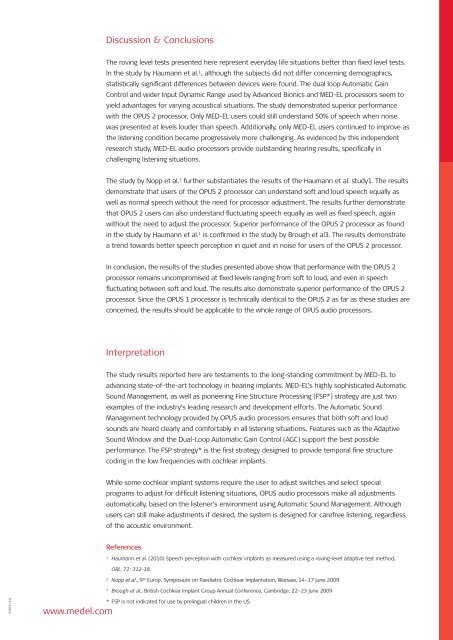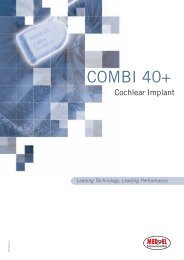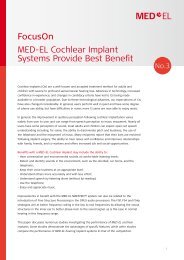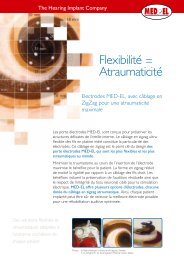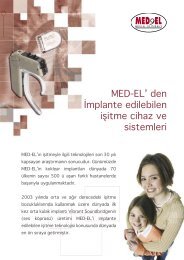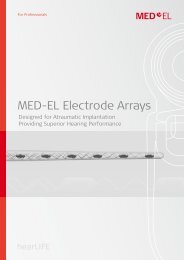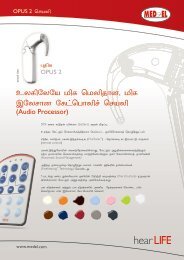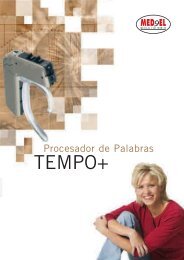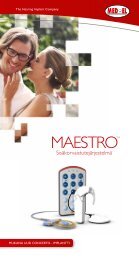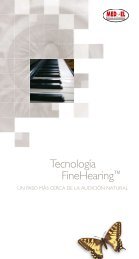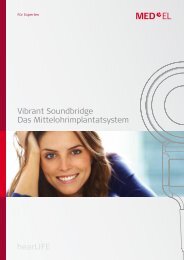A New Benchmark: Speech Perception in Everyday Life ... - Med-El
A New Benchmark: Speech Perception in Everyday Life ... - Med-El
A New Benchmark: Speech Perception in Everyday Life ... - Med-El
You also want an ePaper? Increase the reach of your titles
YUMPU automatically turns print PDFs into web optimized ePapers that Google loves.
22076 r3.0<br />
Discussion & Conclusions<br />
The rov<strong>in</strong>g level tests presented here represent everyday life situations better than fixed level tests.<br />
In the study by Haumann et al. 1 , although the subjects did not differ concern<strong>in</strong>g demographics,<br />
statistically significant differences between devices were found. The dual loop Automatic Ga<strong>in</strong><br />
Control and wider Input Dynamic Range used by Advanced Bionics and MED-EL processors seem to<br />
yield advantages for vary<strong>in</strong>g acoustical situations. The study demonstrated superior performance<br />
with the OPUS 2 processor. Only MED-EL users could still understand 50% of speech when noise<br />
was presented at levels louder than speech. Additionally, only MED-EL users cont<strong>in</strong>ued to improve as<br />
the listen<strong>in</strong>g condition became progressively more challeng<strong>in</strong>g. As evidenced by this <strong>in</strong>dependent<br />
research study, MED-EL audio processors provide outstand<strong>in</strong>g hear<strong>in</strong>g results, specifically <strong>in</strong><br />
challeng<strong>in</strong>g listen<strong>in</strong>g situations.<br />
The study by Nopp et al. 2 further substantiates the results of the Haumann et al. study1. The results<br />
demonstrate that users of the OPUS 2 processor can understand soft and loud speech equally as<br />
well as normal speech without the need for processor adjustment. The results further demonstrate<br />
that OPUS 2 users can also understand fluctuat<strong>in</strong>g speech equally as well as fixed speech, aga<strong>in</strong><br />
without the need to adjust the processor. Superior performance of the OPUS 2 processor as found<br />
<strong>in</strong> the study by Haumann et al. 1 is confirmed <strong>in</strong> the study by Brough et al3. The results demonstrate<br />
a trend towards better speech perception <strong>in</strong> quiet and <strong>in</strong> noise for users of the OPUS 2 processor.<br />
In conclusion, the results of the studies presented above show that performance with the OPUS 2<br />
processor rema<strong>in</strong>s uncompromised at fixed levels rang<strong>in</strong>g from soft to loud, and even <strong>in</strong> speech<br />
fluctuat<strong>in</strong>g between soft and loud. The results also demonstrate superior performance of the OPUS 2<br />
processor. S<strong>in</strong>ce the OPUS 1 processor is technically identical to the OPUS 2 as far as these studies are<br />
concerned, the results should be applicable to the whole range of OPUS audio processors.<br />
Interpretation<br />
The study results reported here are testaments to the long-stand<strong>in</strong>g commitment by MED-EL to<br />
advanc<strong>in</strong>g state-of-the-art technology <strong>in</strong> hear<strong>in</strong>g implants. MED-EL’s highly sophisticated Automatic<br />
Sound Management, as well as pioneer<strong>in</strong>g F<strong>in</strong>e Structure Process<strong>in</strong>g (FSP*) strategy are just two<br />
examples of the <strong>in</strong>dustry’s lead<strong>in</strong>g research and development efforts. The Automatic Sound<br />
Management technology provided by OPUS audio processors ensures that both soft and loud<br />
sounds are heard clearly and comfortably <strong>in</strong> all listen<strong>in</strong>g situations. Features such as the Adaptive<br />
Sound W<strong>in</strong>dow and the Dual-Loop Automatic Ga<strong>in</strong> Control (AGC) support the best possible<br />
performance. The FSP strategy* is the first strategy designed to provide temporal f<strong>in</strong>e structure<br />
cod<strong>in</strong>g <strong>in</strong> the low frequencies with cochlear implants.<br />
While some cochlear implant systems require the user to adjust switches and select special<br />
programs to adjust for difficult listen<strong>in</strong>g situations, OPUS audio processors make all adjustments<br />
automatically, based on the listener’s environment us<strong>in</strong>g Automatic Sound Management. Although<br />
users can still make adjustments if desired, the system is designed for carefree listen<strong>in</strong>g, regardless<br />
of the acoustic environment.<br />
References<br />
1 Haumann et al. (2010) <strong>Speech</strong> perception with cochlear implants as measured us<strong>in</strong>g a rov<strong>in</strong>g-level adaptive test method,<br />
ORL, 72: 312-18.<br />
2 Nopp et al., 9 th Europ. Symposium on Paediatric Cochlear Implantation, Warsaw, 14–17 June 2009<br />
3 Brough et al., British Cochlear Implant Group Annual Conference, Cambridge, 22–23 June 2009<br />
* FSP is not <strong>in</strong>dicated for use by prel<strong>in</strong>gual children <strong>in</strong> the US.<br />
www.medel.com


